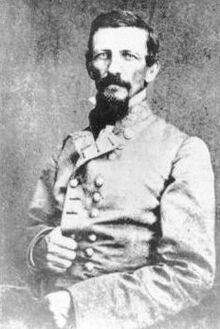Alexander P. Stewart facts for kids
Quick facts for kids
Alexander Peter Stewart
|
|
|---|---|

Alexander Stewart, photo taken during American Civil War
|
|
| Born | October 2, 1821 Rogersville, Tennessee |
| Died | August 30, 1908 (aged 86) Biloxi, Mississippi |
| Place of burial | |
| Allegiance | |
| Service/ |
|
| Years of service | 1842–1845 (USA) 1861–1865 (CSA) |
| Rank | |
| Unit | 3rd U.S. Artillery Regiment |
| Commands held | 2nd Brigade, 1st Division, Polk's Corps Stewart's Division, Buckner's Corps Third Corps, Army of Tennessee Army of Tennessee |
| Battles/wars | American Civil War
|
| Other work |
|
| Signature | |
Alexander Peter Stewart (born October 2, 1821 – died August 30, 1908) was an important figure in American history. He was an officer in the United States Army and later a general for the Confederate States Army during the American Civil War. He also worked as a college professor. Stewart fought in many major battles in the western part of the war. He even led the Army of Tennessee for a short time in 1865.
Contents
Early Life and Education
Stewart was born in Rogersville, Tennessee. He went to the United States Military Academy, also known as West Point. He graduated in 1842, ranking 12th in his class. After graduating, he became a second lieutenant in the 3rd U.S. Artillery Regiment.
In 1845, he left the army. He decided to become a professor. He taught mathematics at Cumberland University in Lebanon, Tennessee. Later, he taught at the University of Nashville.
Civil War Service
When the American Civil War began in 1861, Stewart joined the Confederate Army. Even though he didn't support states leaving the Union, he accepted a role as a major in the Tennessee Militia. Soon after, he became a major in the Confederate States Army.
Early Battles
Stewart quickly rose through the ranks. He became a brigadier general in November 1861. He led a group of soldiers called a brigade. His brigade was involved in defending areas in Kentucky.
In April 1862, his men joined the Army of Mississippi. They fought in the Battle of Shiloh. This was a very important and bloody battle. Stewart led his brigade in attacks on a key area called the "Hornet's Nest."
After Shiloh, Stewart was present at the Siege of Corinth. This was a time when Union forces surrounded the city of Corinth.
Major Engagements
Later, Stewart's brigade fought at the Battle of Perryville. This battle was part of a Confederate plan to invade Kentucky. The Army of Mississippi then became known as the Army of Tennessee. Stewart continued to serve in this army.
He fought at the Battle of Stones River near the end of 1862. In June 1863, Stewart was promoted to major general. He was given command of a larger group of soldiers called a division. His division fought at the Battle of Hoover's Gap.
Stewart's division also fought in the Battle of Chickamauga. This was another very fierce battle. Stewart was wounded during the fighting on September 19. After Chickamauga, his division fought at the Battle of Missionary Ridge in November 1863.
Atlanta Campaign and Final Battles
In 1864, Stewart led a division during the Atlanta Campaign. This was a series of battles around Atlanta, Georgia. He fought at Rocky Face Ridge, Resaca, and New Hope Church.
Stewart was then given command of the Third Corps. He was promoted to temporary Lieutenant General in June 1864. He led his troops in the Battle of Peachtree Creek. His headquarters during this time was at the home of Georgia's Quartermaster General, Ira Roe Foster.
Stewart also led the Third Corps at the Battle of Ezra Church. He was wounded in the forehead during this battle on July 28.
He continued to lead the Third Corps in the Franklin-Nashville Campaign in late 1864. He participated in the Battle of Franklin and the Battle of Nashville. His corps faced difficulties during the Battle of Nashville.
In 1865, what was left of the Army of Tennessee, with fewer than 5,000 men, was placed under Stewart's command. He surrendered the army on April 26, 1865. He was released from service on May 1.
After the War
After the Civil War, Stewart moved to Missouri in 1869. He worked as an executive for an insurance company. In 1874, he moved to Mississippi. There, he became the Chancellor of the University of Mississippi. He held this important position until 1886.
From 1890 to 1908, Stewart served as a commissioner. He helped manage the Chickamauga and Chattanooga National Military Park. This park preserves important Civil War battlefields.
Stewart was injured in 1893 when he was hit by a train. He moved back to Missouri in 1906. He passed away in Biloxi, Mississippi in 1908. He is buried in Bellefontaine Cemetery in St. Louis, Missouri.
See also
- List of American Civil War generals (Confederate)
- Rogersville, Tennessee
- Cumberland University
- University of Nashville
- University of Mississippi

